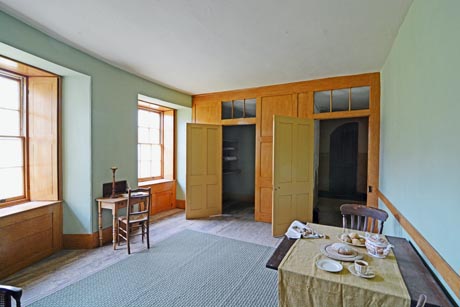How did our servants’ basement manage to stay untouched for so long?
We often get asked the question how our basement managed to stay untouched for so long. Well, here is the story.
Many years ago Nick Tyson, the curator, became friends with an elderly lady that lived in the basement of №10 Brunswick Square. He would fetch her groceries. He discovered that her home was a ‘time capsule’ full of original Regency features. It was virtually untouched by time.

Nick says:
"Her parents had worked as housekeepers/caretakers in 9 & 10 Brunswick Square. After their death, she stayed on in that position at a wage of £2.6s a week. She would gladly allow me to record all her memories. She would never pose for a photograph, saying she didn’t want any fuss. She was always embarrassed at how old fashioned and plainly decorated her home was. She found it difficult to believe she was living in an architectural gem! The basement contained many startling features such as a walk-in meat safe. This had wire mesh panels to keep the meat cool and bug free.The wine cellar door even had remains of the wax used by the butler to seal over the lock. This prevented light fingered servants from tampering with it while he was away."
Later, when she was in her 80’s and in poor health, she was moved into sheltered accommodation and the whole building was sold to developers. It was then that Nick decided to try to preserve her wonderful home.
The development company gave The Regency Town House three months to raise the money needed — the race was on! A bid to the newly created National Lottery was made but additional monies were essential and so a huge fund raising campaign was put into action.
People were invited to visit the basement and see for themselves how valuable it was. Nick recalls:
"The interest in №10 was phenomenal. People were so impressed with what they saw that many visitors made contributions on the spot and even sent in second donations. They were determined not to sit back and let an historical gem end up in a builders skip. The general public gave nearly £15,000 and the developers kindly agreed to wait a few more months. It was announced in June 1995 that the Regency Town House was the recipient of the first ever Heritage Lottery Fund grant in the South East and with their support the basement was saved”.
The acquisition of the basement paved the way for the project seen today but it also greatly increased the physical repair demands faced by Nick and the Town House team.
Since we acquired the basement at №10 in 1995, we have had a daily struggle to stay ahead of the fabric maintenance demands the two properties dictate.
“Our buildings decay daily, in response to the vagaries of the UK weather. There’s a never-ending list of works to do”, says Nick Tyson, Curator at The Regency Town House. "Each year, we have laboured to arrest decomposition and do a little more too. Each extra repair moves us closer to returning the properties to a fully restored state. Then they can function well as historic properties. They will educate the public about life in early-19th century Brighton & Hove."
Much of this work is unseen by the general visitor. It occurs on locations such as parapets or roofs, out of site. Or it replaces a modern material with a traditional one. An example of the latter instance occurred a few years ago.
We decided to replace the concrete screed covering the back yard with York stone slabs. This was to re-establish the original finish. Either material provides a hard and weather resilient finish to the back yard. It’s not immediately obvious to visitors that one has been removed and the other introduced.
But Nick argues that it is a demanding and significant task. Nick says, “There were obvious benefits of reinstating stone. The project, though, also led to us discovering the original and functional well to the House. That was an exciting find. I thought it might have filled in long ago.”




Add new comment